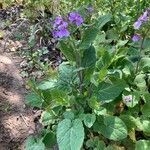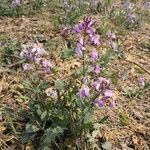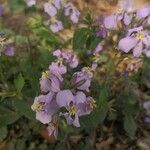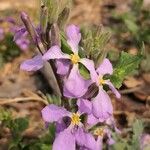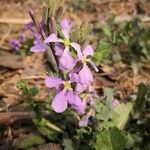Herbs annual or biennial, (6-)15-60(-90) cm tall. Stems erect, simple or branched at base, often branched above, straight, glabrous or sparsely to densely pilose. Basal leaves not rosulate; petiole (1-)2-8(-11) cm; blade or terminal leaf lobe cordate, reniform, broadly ovate, or suborbicular, (0.4-)1.5-10(-14) × (0.3-)1-4(-7) cm, glabrous or pilose, base cordate or rarely obtuse, margin coarsely crenate with teeth ending in apiculae, apex acute or obtuse; lateral lobes 1-6 on each side, sessile or petiolulate, to 3 × 2 cm, sometimes absent. Uppermost cauline leaves auriculate or amplexicaul, sessile or petiolate, (0.5-)2-9(-15) × (0.2-)1-6(-9) cm, margin coarsely and irregularly dentate, rarely entire, apex acute or acuminate; auricles to 3 × 4 cm; lateral lobes absent or 1-4 on each side, sessile or petiolulate. Fruiting pedicels divaricate, glabrous or pilose, narrower than fruit, (0.6-)0.8-2(-3) cm. Sepals linear, erect, connivent, (0.6-)0.8-1.3(-1.6) cm × 1.5-2.5 mm, base of lateral pair strongly saccate. Petals deep purple, lavender, or white, broadly obovate, (1.2-)1.6-2.5(-3.2) cm × (4-)5-9(-11) mm, apex rounded; claw as long as sepals. Filaments 0.8-1.8 cm; anthers linear, (3-)4-6(-8) mm, distinctly apiculate. Ovules (20-)40-70 per ovary. Fruit narrowly linear, stout, terete or somewhat 4-angled, (3-)4.5-11(-13) cm × 1.5-3 mm; valves glabrous or densely hirsute, torulose, usually with a prominent midvein; style (0.3-)0.7-3(-5.5) cm; stigma slightly to distinctly 2-lobed, lobes decurrent. Seeds oblong, 2-3(-3.5) × 1-2 mm. Fl. Mar-Jun, fr. May-Jul. 2n = 24.
More
Stems (0.6-)1.5-6(-9) dm, often branched distally, glabrous or sparsely to densely pilose. Basal leaves: petiole (1-)2-8(-11) cm; blade or terminal lobe cordate, reniform, broadly ovate, or suborbicular, (0.4-)1.5-10(-14) cm × (3-)10-40(-70) mm, base usually cordate, rarely obtuse, margins coarsely crenate with teeth ending in apiculae, apex acute or obtuse; lobes (0 or) 1-6 each side, sessile or petiolulate (to 3 × 2 cm), glabrous or pilose. Cauline leaves sessile or petiolate; (distal) blade (0.5-)2-9(-15) cm × (2-)10-60(-90) mm, base sometimes auriculate or amplexicaul, margins dentate or entire, apex acute or acuminate (auricles to 3 × 4 cm); lobes (0 or) 1-4 each side, sessile or petiolulate, glabrous or pilose. Fruiting pedicels (0.6-)0.8-2(-3) cm, narrower than fruit, glabrous or pilose. Flowers: sepals connivent, (6-)8-13(-16) × 1.5-2.5 mm; petals (12-)16-25(-32) × (4-)5-9(-11) mm; filaments 8-18 mm; anthers (3-)4-6(-8) mm. Fruits (3-)4.5-11(-13) cm × 1.5-3 mm; style (0.3-)0.7-3(-5.5) cm; stigma slightly to distinctly 2-lobed. Seeds 2-3(-3.5) × 1-2 mm. 2n = 24.
A cabbage family herb which takes 1 or 2 years to complete its life cycle. It grows 50 cm high and spreads 30 cm wide. The leaves near the base are thin and lyre shaped. They are divided into lobes along the stalk. The leaves on the stem are simple and oval. The flowers have 4 petals. They are violet. The flowers occur in clusters. The pod is 7-10 cm long and has 4 ridges. It has a beak 2-3 cm long. The seeds are black-brown.
It grows on roadsides, gardens, forests, fields, thickets, valleys, hillsides, sunny slopes; near sea level to 1500 m altitude in China. It is often self-sown under Juniper and Thuja trees. It suits hardiness zones 9-11. In Sichuan.
More
Roadsides, gardens, forests, fields, thickets, valleys, hillsides and sunny slopes from near sea level to 1500 metres.
